
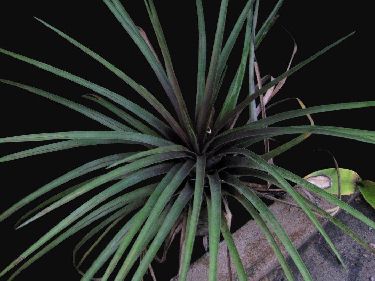
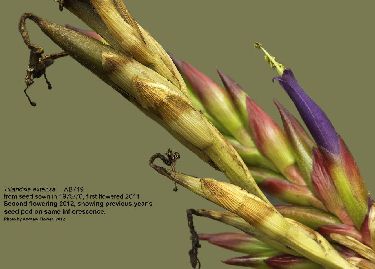
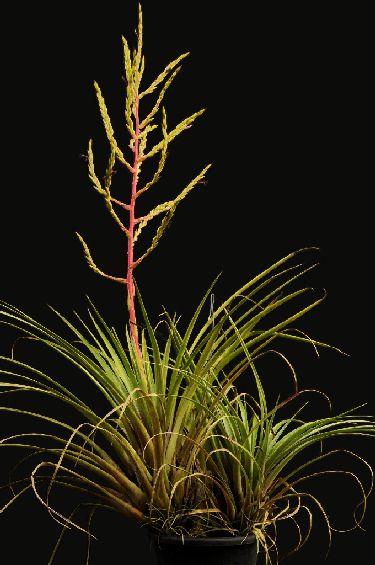
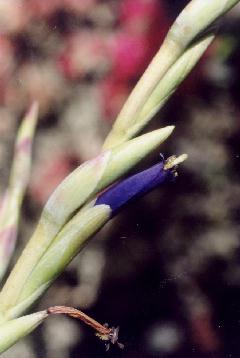
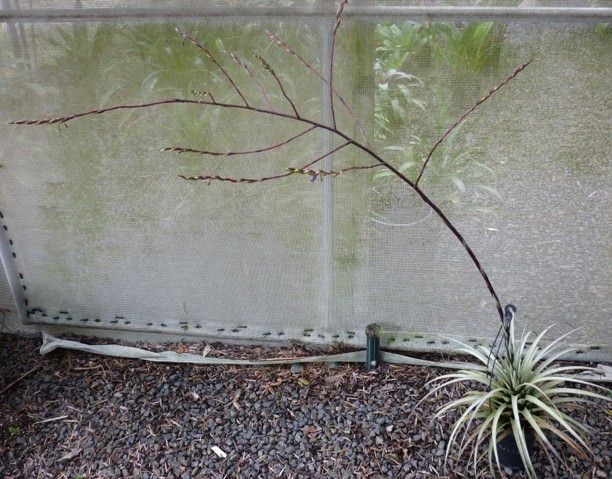

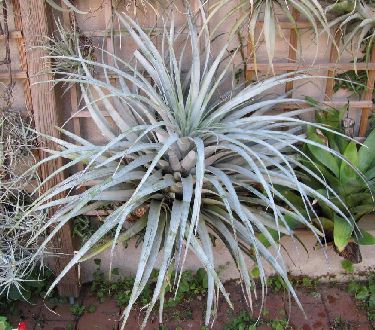
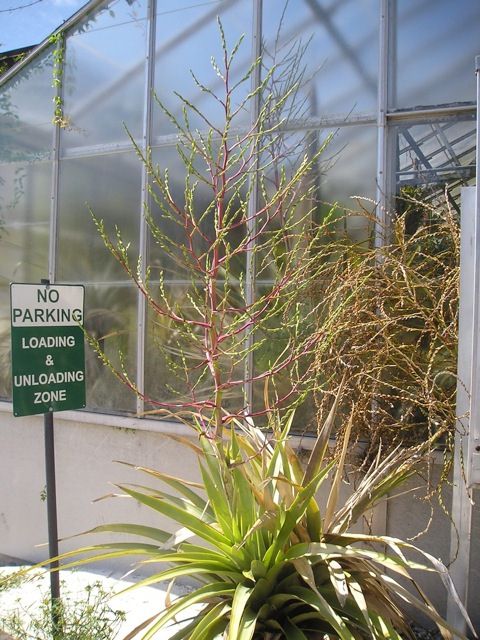
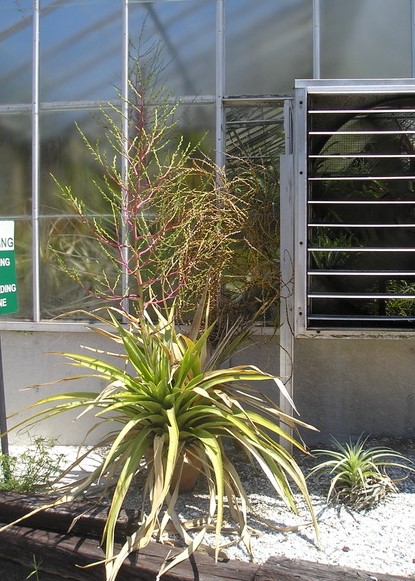

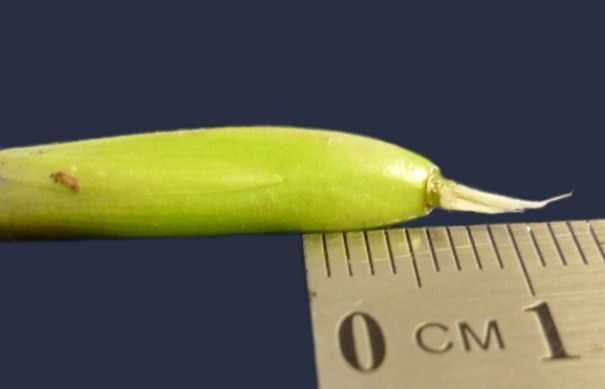
Peter Tristram...."I saw monster examples of this in Heidelberg BG and other collections in Germany, as well as relatively small ones like this.
It seems they can bloom at nearly any size! I flowered a very small one, half the size of this baby, recently too.
It seems to grow much better in a dry climate though. It should produce many viviparous pups too. The one in the pic is ex KK but 20 years old and about 1m in width. The extensas were collected in 2003 on the other side of the range to where the mima v chiletensis grows, in a gorge as you head into the Andes inland from Chiclayo, near Chongoyape - so it has provenance! It is actually mounted, though I usually pot these terrestrial types."
Derek Butcher...."When I first saw Bruce's plant I thought it cannot be var chiletensis because it does not have viviparous offsets.
Werner Rauh has been involved with most of these sorts of Peruvians and he loved to create a variety because of this propensity to have offsets in the inflorescence. The only difference left between Bruce's plant and the type is that Bruce's plant should have sepals joined for 3-4 mm. This is a measurement I cannot see with my ancient naked eye but would resort to scanning and magnification. But Bruce is younger than I!
What I am trying to say is that I don't think we should pay too much attention to varieties where Werner made many judgements based on viviparousness!
If anything I would call Bruce's plant Mima Minor!"
Bruce Dunstan...."I think it may be a little early for viviparous offsets.
My T. propuligifera took a couple of months after flowering to make pups on the flower spike.
T. mima seems to be a variable species in size. Plants of another clone I have tend to have very succulent silvery leaves and don't like to be grown wet, rotting very easily.
The first attached image was taken at Selby The second was on the way from Cali to Buenaventura in a very arid area. Down in the Cauca River valley in Colombia where they get more rain the T. mima growing in trees along the highway were huge, over 2m accross.
I pulled a flower apart and the sepals are fused for 6-7mm."
Peter Tristram...."Bruce, but where do the sepals start?
My dead flowers on one I bloomed last year measure about 3 or 4mm fused - and they are from the same stock too."

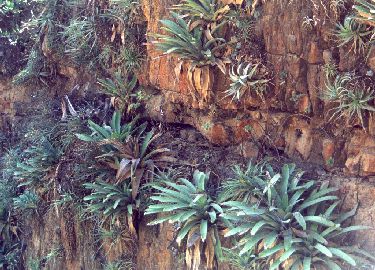
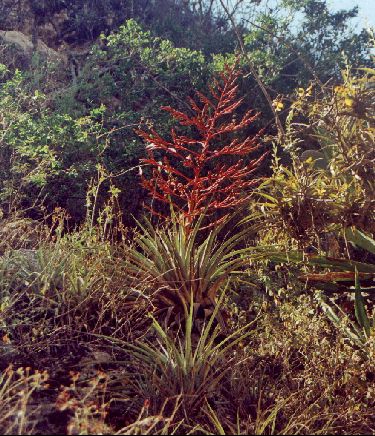
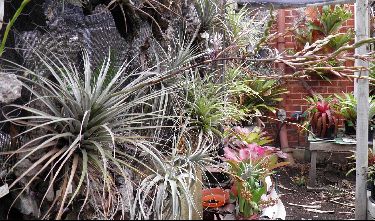
Bruce Dunstan, 26/04/13 4:53pm.... Derek, do you know where you sourced your plant from ? I have a very silvery plant from Peter who got it from Knize that is in spike at the moment, but no ideas on viviparous pups.
Derek Butcher.... Bruce. Surprise surprise. Mine came from Knize about 30 years ago as hitchcockiana. It seems a smaller more silvery extensa than what you lot grow in the east. Perhaps I should get used to pseudoviviparous.
Ray, 26/04/2013 4:05pm.... Derek, not knowing what viviparous meant, I used the wonder of the iMac to inform myself as copied and pasted below, does this mean that the buds formed whilst flowering or on the old flower spike after flowering? As for T extensa, I have no prior knowledge of it's habits. In plants, it means "reproduction via embryos, such as buds, that develop from the outset without interruption, as opposed to germinating externally from a seed."
Derek Butcher, 26/04/2013 4:13pm.... Newbies please note. Bromeliaceae terms have been influenced by Americans (Viz Lyman Smith) which is why I concocted a Glossary so I can swot up from time to time. This is why I have a Glossary on the Tillnuts DVD. You can ponder whether I was correct in using viviparous and not pseudoviviparous! In my thirst for such valuable knowledge I am now trying to trace what phyllanthidea means. Mez used this word in 1896 and nobody so far including David Benzing (who loves to use long words) has been much help. It was used as a genus name in Euphorbiaceae in 1857 and Euphorbia have some odd flowers. I haven't given up yet.
Bob Hudson, 26/4/13 6:27pm.... Here is a photo of Tillandsia extensa I got from Grace Good many years ago.
Andrew Flower, 27/04/13 5:28pm.... My T. extensa has no offsets on the infloresence UD, but it does flower in successive years on the same inflorescence - see pic.
This plant was grown from seed I received in 1975/76 with a Rauh collection number on it. Unfortunately the number got lost over the years. It flowered for the first time in 2011 (do the math!) and again on the same inflorescence in 2012. It is self fertile but (again doing the math) I decided not to bother sowing seed of it this time. It also pups profusely.
Derek Butsher, 28/04/13 7:47pm.... Andrew, I thought that only Deuterocohnia were supposed to do that. Will add your photo to the Tillnuts DVD if only to prove that nature knows no rules!
Peter Tristram, 29/04/13 12:30pm.... Photos of T. extensa from home and habitat shots (Chongoyape Peru).
For me extensa frequently blooms for a second year, usually after appearing to stop, seed pods set as well, either on new branches or extensions of the original ones, but I can't remember a third or more season of blooming. I have never had viviparous whatever pups on them either and I would like to see a photo of the whole of Derek's plant in case it's a mima v. chiletensis or some other similar species. It doesn't look like propagulifera though.
I'd also love to see the plant Bruce is blooming (hint) as we might be able to figure out what it is. All of my forms (Knize, Heidelberg, BRT, Tropiflora, self-collected and probably a few more sources) give adventitious pups.
Attached are few pics of it in habitat and a plant from that site blooming at sunny Repton. It was collected in 2003 on the other side of the range to where T. mima v chiletensis grows, in a gorge as you head into the Andes inland from Chiclayo, near Chongoyape - so it has provenance! It is actually mounted to stunt it, though I usually pot these terrestrial types. The cliff pic features species like T. teres, extensa, hitchcockiana/cereicola, R. multiflora and some spiny stuff.
Derek Butcher, 29/4/13 2:44pm.... Photo of whole plant, now labelled T. mima v. chiletensis
Peter, you have it in one. I am now fairly certain I do have T. mima v. chiletensis. Photo of plant attached. When taking the photo I noticed that flowers were distichous leading to T. extensa but on branches now becoming herbarium material they were clearly secund pointing to T. mima! All of this needs recording for future queries!
Peter Tristram, 1/05/2013 06:34pm.... Derek, the viviparous bit got me thinking so I checked your inflorescence against a T. mima v. chiletensis in my greenhouse and decided it just had to be. This is a very slow species for me and I really need a drier spot for them. I saw huge ones in Germany too where they must take a lifetime to bloom.
Derek Butcher..... You think yours are slow. Mine took over 30 years! 5 years back Adam Bodzioch used Ethrel and got a one branched spike and a single flower which I identfied correctly. My plant took a further 5 years to do its thing naturally and got wrongly identified as T. extensa.!
That's the way the cookie crumbles >:-}
From the table below you can see the leaves of T. mima are half as long, floral bracts and sepals are longer. The plants I examined from that area had Floral bracts 21 mm and sepals 11 mm, so more like T. marnier-lapostollei. I think many specimen in collections are wrongly named.
I think Rauh himself has mistaken the two species when he described: Tillandsia mima var. chiletensis Rauh Trop. Subtrop. Pflanzenw. 21: 24-8. (1977)
He used Rauh 35081 to compare this new var. with, but this was not Tillandsia mima, but Tillandsia marnier-lapostollei Rauh Trop. Subtrop. Pflanzenw. 3: 6 fig. 1-3 (1973)
I re-identified this specimen from the US duplicate: floral bracts less than 1 cm and sepals 12 mm long.
The question raises: is var. chiletensis related to mima or marnier-lapostollei or just an other species?
Eric
| Tillandsia marnier-lapostollei Rauh - Akad. Wiss. & Lit. Mainz 1973 (3): 6, fig. 1-3. 1973 Rauh (L=1450) | Tillandsia mima L B Smith - Caldasia. 3: 244. 1945 L B Smith (L=1043) | Plant short-caulescent, with basal offsets, flowering 2.5 m high stem to 5 dm long and 15 cm thick | Plant stemless, 2-4 m high | Leaves numerous in a broadly funnelform rosette, to 12 dm long | Leaves rosulate, nearly 7 dm long | Sheaths merging with the blades, 25 cm long, 15 cm wide, covered with fine closely appressed scales, blackish brown above, lighter beneath | Sheaths oblong-elliptic, inconspicuous, very densely and minutely castaneous-lepidote | Blades ligulate with an attenuate apex, 13 cm wide, covered with fine appressed white scales, becoming glabrous above with age, reddish toward apex | Blades narrowly triangular, attenuate, 5-6 cm wide, densely and minutely white-lepidote on both sides | Peduncle erect, ca 1 m high, 3 cm thick at base, carmine red, glabrous | Peduncle erect, 2 cm in diameter, glabrous | Peduncle-bracts exceeding the 11 cm long internodes, the basal subfoliaceous, the upper broadly ovate, acute, green at base, red-brown and red-punctate at apex, sparsely lepidote | Peduncle-bracts foliaceous, erect, imbricate | Inflorescence very laxly tripinnate, ca 1 m high and 1.5 m wide | Inflorescence very laxly 2-3-pinnate, glabrous | Axes flexuous, lustrous carmine red | - | Primary-bracts like the upper peduncle-bracts, much shorter than the 10 cm long laxly bracteate sterile bases of the branches | Primary-bracts lanceolate, acute, shorter than the sterile bases of the branches | Rhachis flexuous, slender, glabrous | Rhachis flexuous, slender, red-purple | Floral-bracts downwardly secund with the flowers, broadly ovate, obtuse, cucullate, 12-14 mm long, ecarinate, fleshy becoming rugose when dry, sparsely lepidote | Floral-bracts erect, elliptic, apiculate, 20-25 mm long, about equaling the internodes, ecarinate, strongly nerved, subcoriaceous, green at the base, elsewhere violaceous | Pedicels stout, 5 mm long | pedicels stout, angled, 5 mm long | Sepals free, broadly ovate, obtuse, 10-12 mm long, exceeding the floral-bracts convex, glabrous outside, fleshy becoming sulcate | Sepals free, narrowly obovate, broadly acute, ecarinate, to 24 mm long, nerved | Petals narrowly ligulate, slightly exceeding the sepals, blue-violet | Petals linear, 35 mm long, blue-violet | Stamens included | Stamens and style long-exserted | Capsule to 2 cm long, green | Capsule slender, ellipsoid, long-acuminate | spikes to 50 cm long | Branches divergent, 5-9 dm long, laxly many-flowered, prophyllate at the base | flowers downwardly secund | flowers downwardly secund |
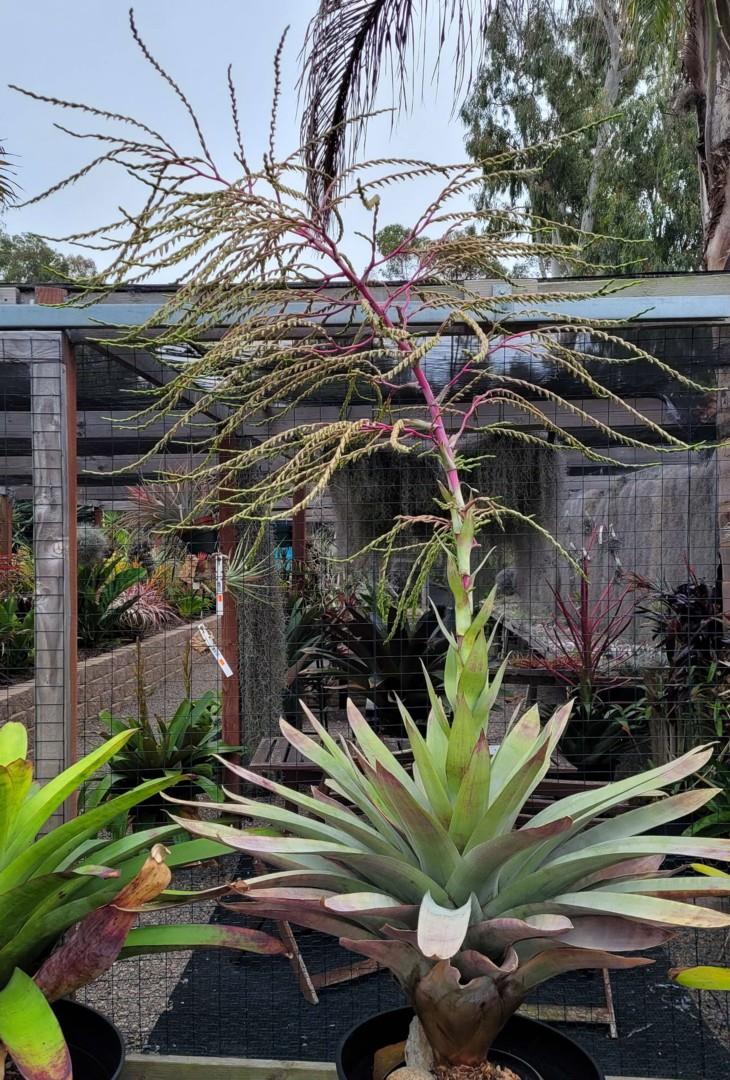
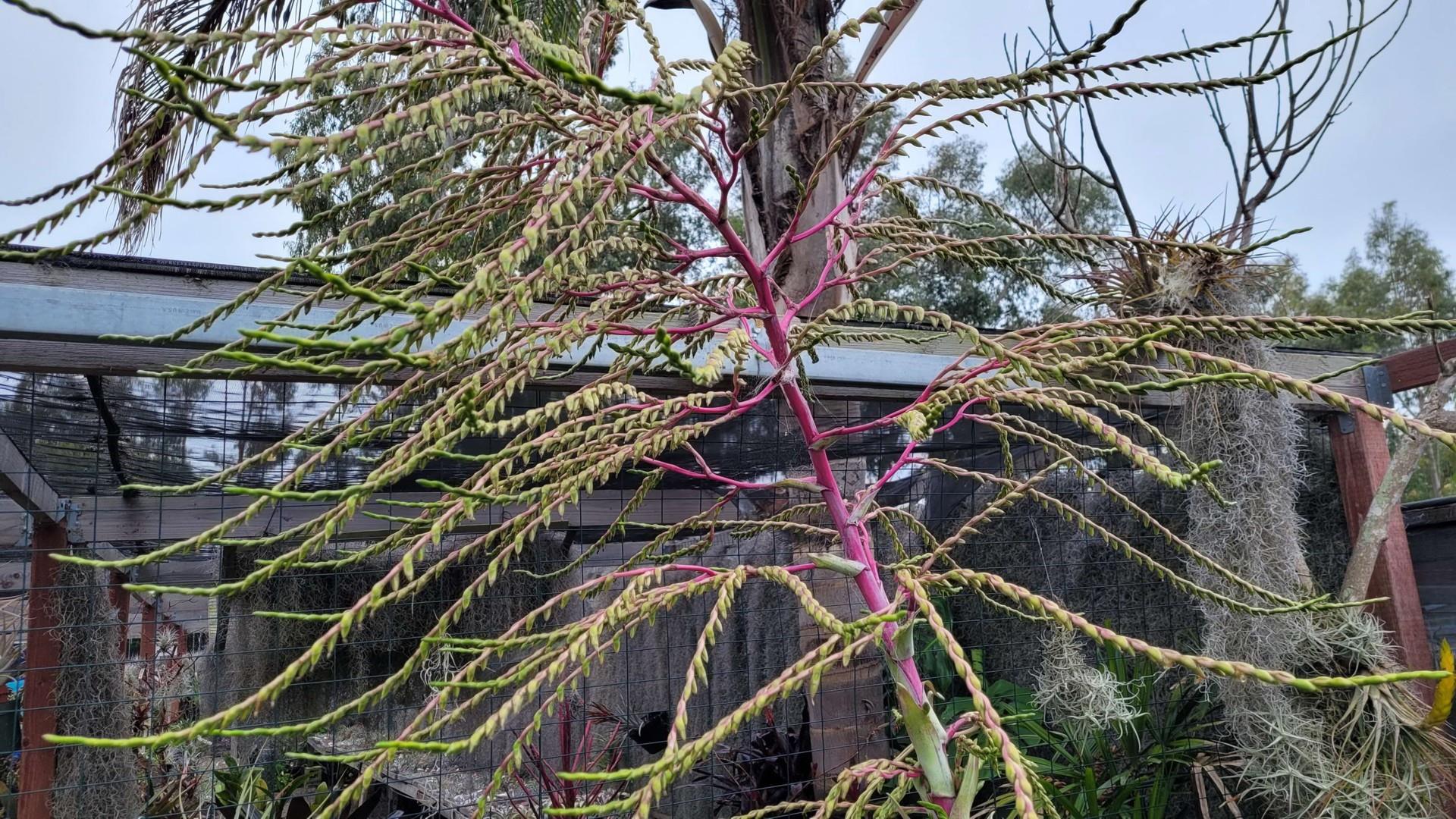
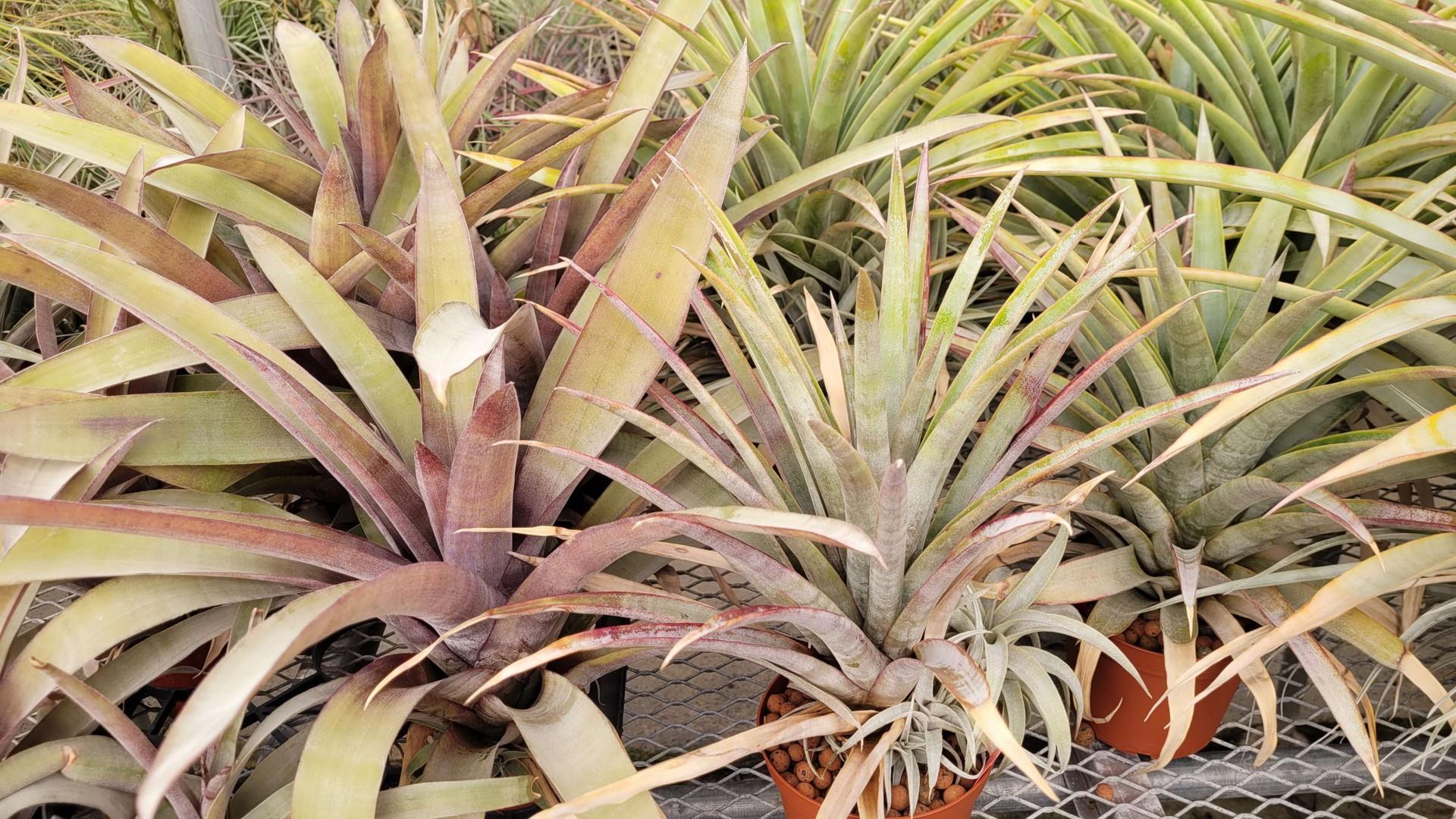
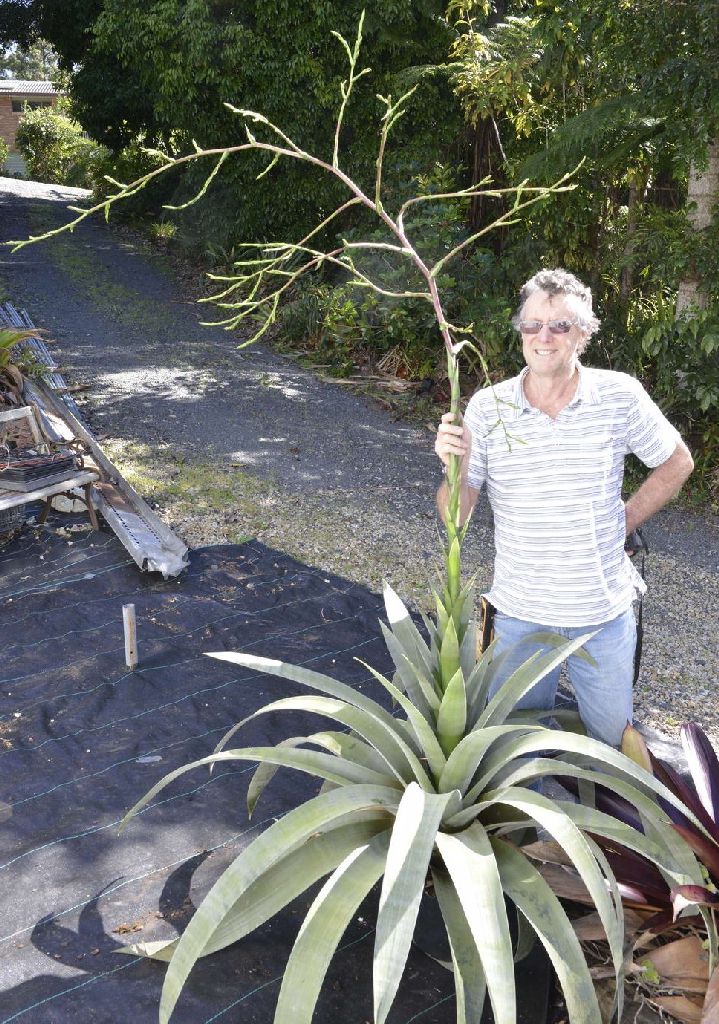
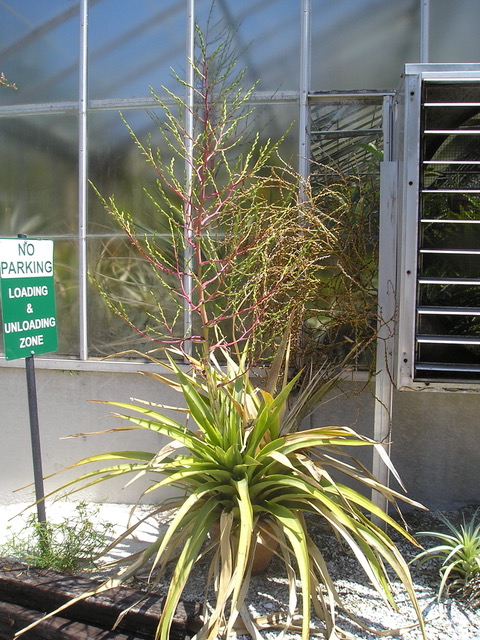


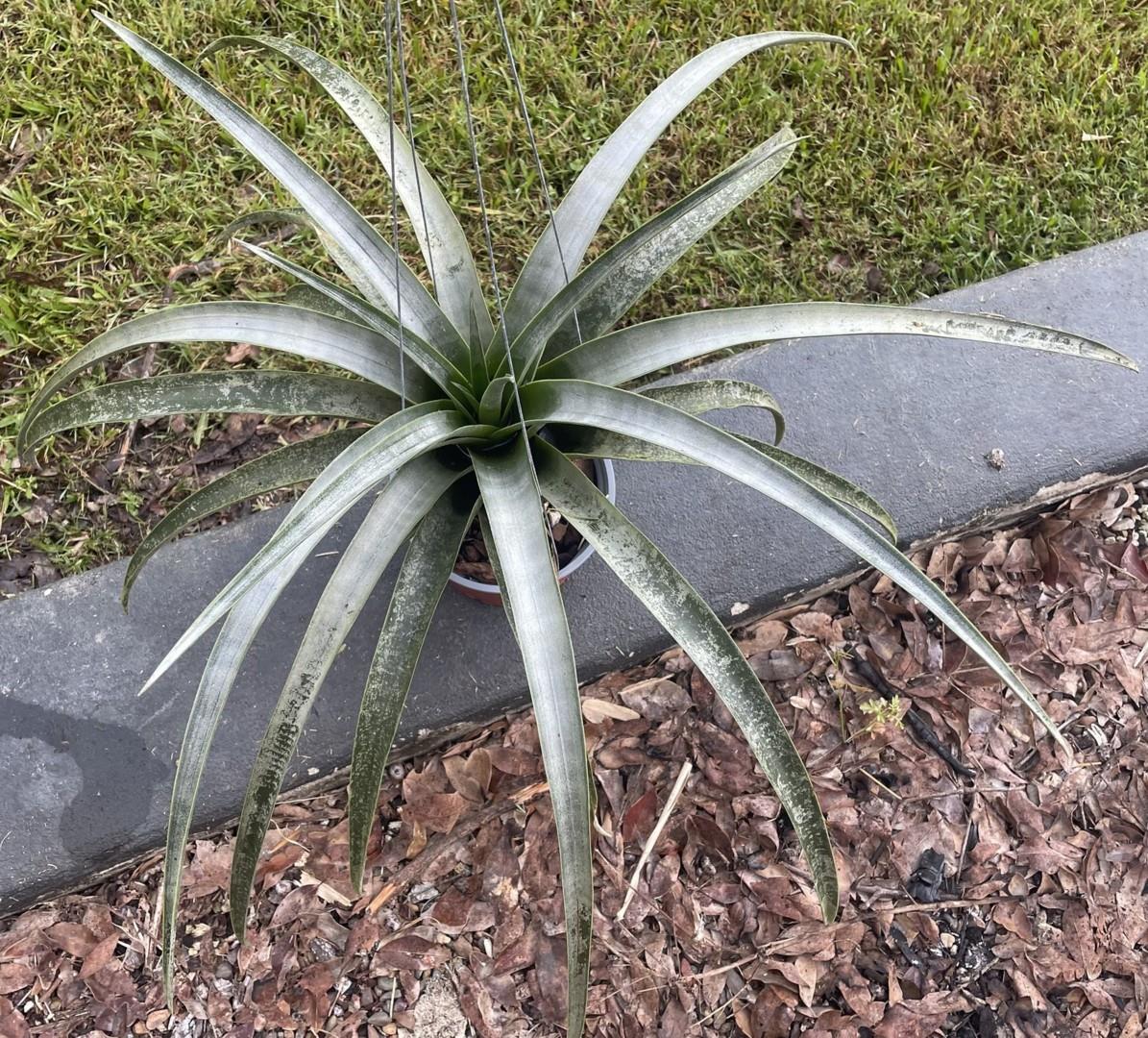
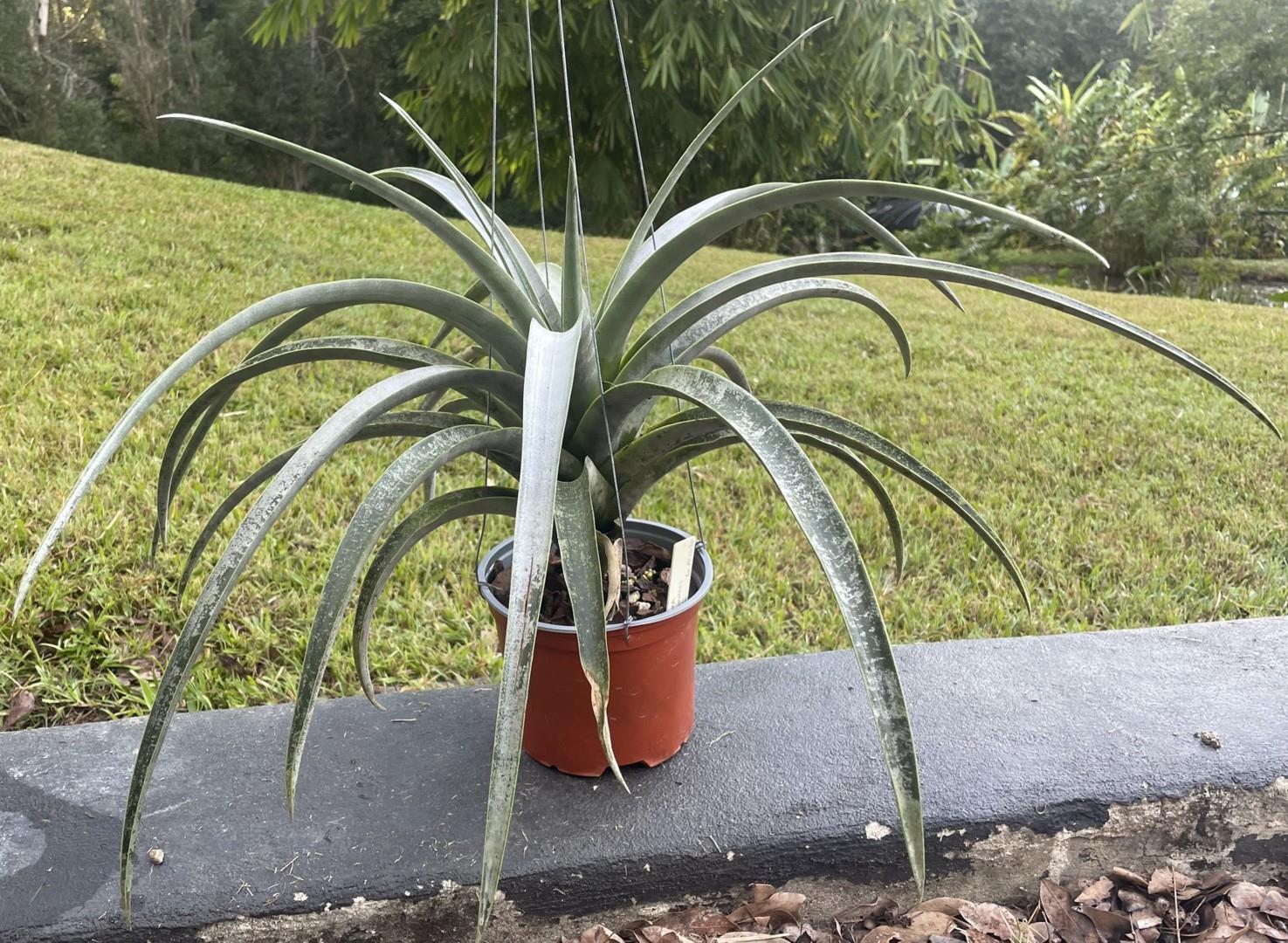
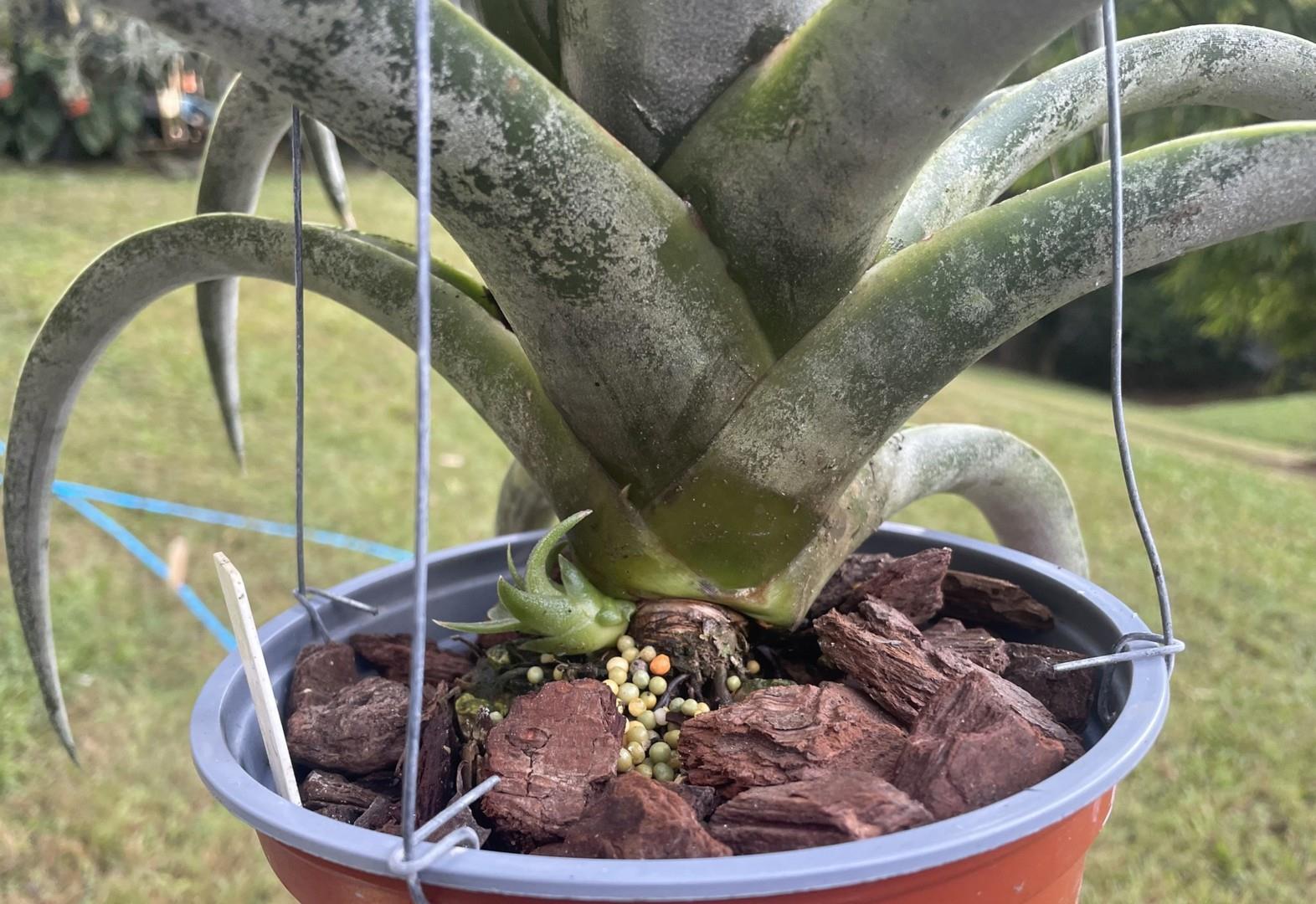
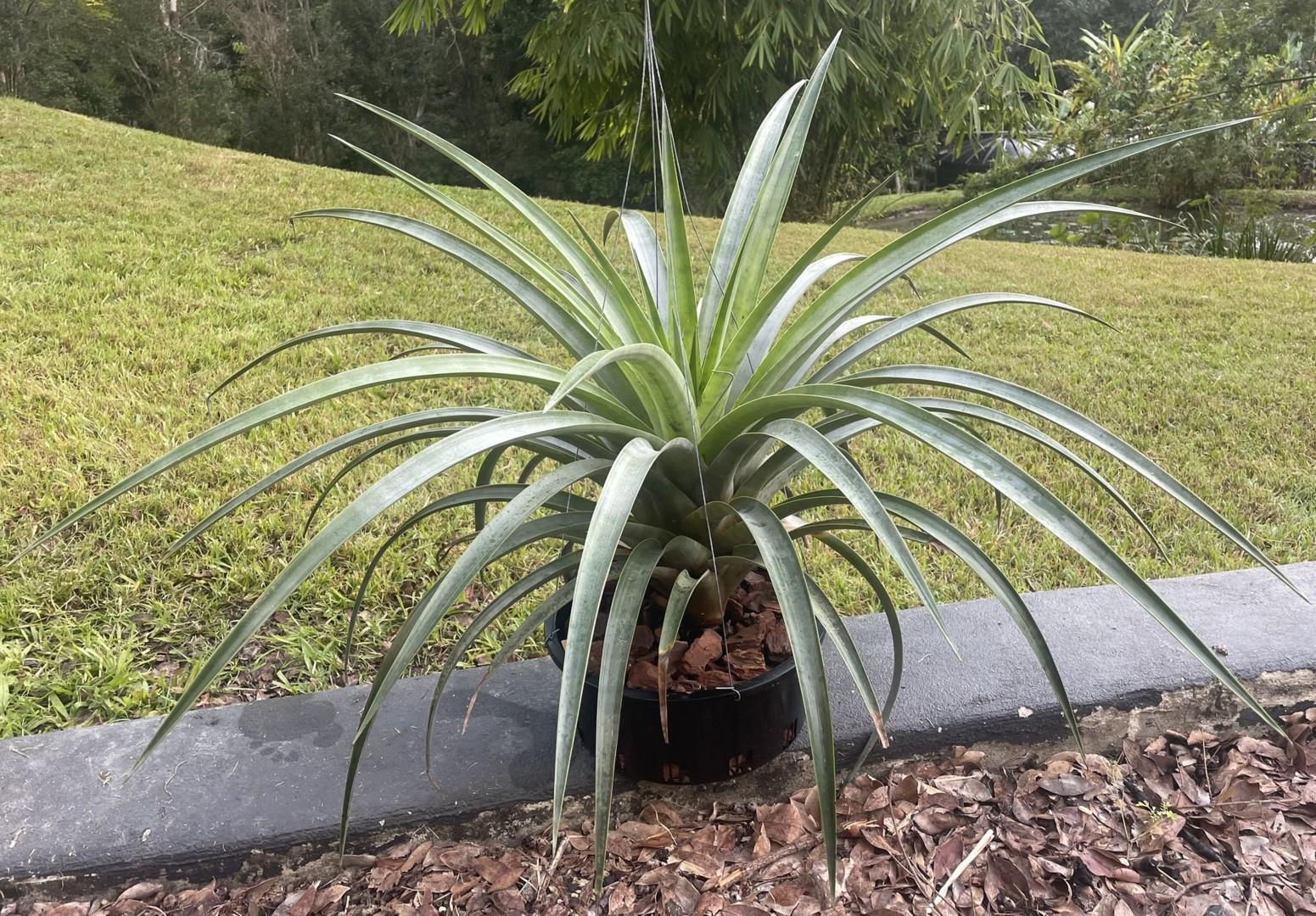
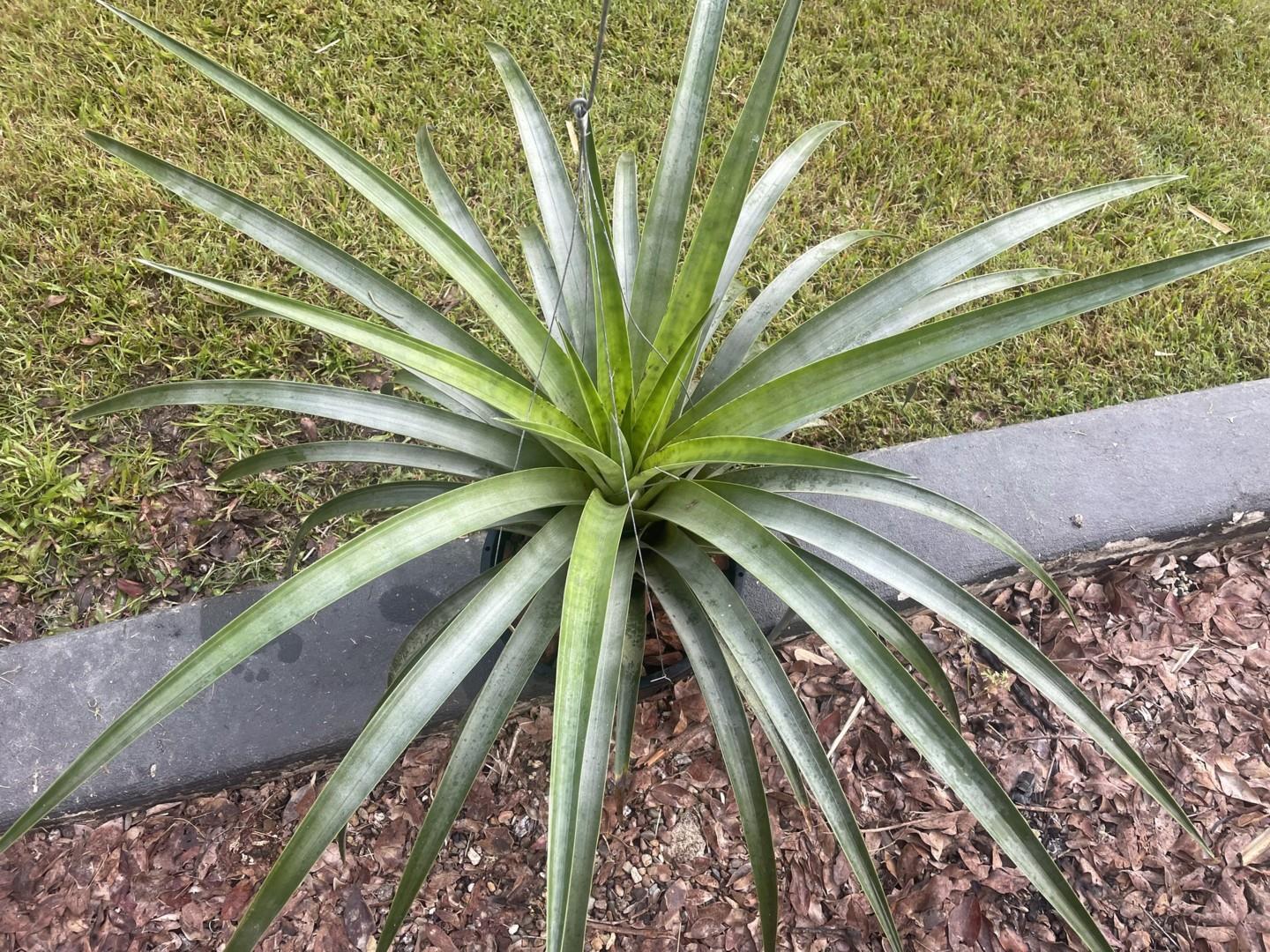
Plant stemless, 2-4 m high.
Leaves rosulate, nearly 7 dm long;
Sheaths oblong-elliptic, inconspicuous, very densely and minutely castaneous-lepidote;
Blades narrowly triangular, attenuate, 5-6 cm wide, densely and minutely white-lepidote on both sides.
Scape erect, 2 cm in diameter, glabrous;
Scape-bracts foliaceous, erect, imbricate.
Inflorescence very laxly 2-3-pinnate, glabrous;
Primary bracts lanceolate, acute, shorter than the sterile bases of the branches;
Branches divergent, 5-9 dm long, laxly many-flowered, prophyllate at the base;
Rhachis flexuous, slender, red-purple.
Floral bracts erect, elliptic, apiculate, 20-25 mm long, about equaling the internodes, ecarinate, strongly nerved, subcoriaceous, green at the base, elsewhere violaceous;
flowers downwardly secund, pedicels stout, angled, 5 mm long.
Sepals free, narrowly obovate, broadly acute, ecarinate, to 24 mm long, nerved;
Petals linear, 35 mm long, blue-violet;
Stamens and style long-exserted.
Capsule slender, ellipsoid, long-acuminate.
TYPE. Cuatrecasas 17816 (holotype GH, isotypes F, US, VALLE), Lobo Guerrero, western slope of the Cordillera Occidental, Valle, Colombia, 9-10 Sep 1944.
DISTRIBUTION. Epiphytic in dry thickets and saxicolous on cliffs, 650-1885 m alt, Colombia, Ecuador. COLOMBIA. VALLE: Buga, Portachuelo, and Vijes, 29 Mar 1876, Andre 2448 in part (K); Boca del Horno, bank of Rio Dagua, Mar 1876, Andre 2448 in part (K); Dagua to LoboGuerrero, 20Nov 1963,Hutchison & Idrobo 3114 (COL, F, NY, UC, US). CAUCA: Rio Piendamo, 10 Apr 1876, Andre 2448 in part (K). NARINO: La Union to Pasto, 25 Oct 1946, Foster 1929 (GH, US). ECUADOR. ORO: Portovelo, Zaruma, Aug-Sep 1923, Hitchcock 21218 (GH, US).
var. chiletensis W. Rauh Trop Subtrop. Pflanz. 21: 21-28. 1977
In all parts smaller than Type.
Plant flowers to 1.2m high (Type ca. 3m)
Leaf rosette 30cm high, 40 – 60cm diam.
Leaf sheath 7.5cm long, 4.5cm wide, leather coloured.
Leaf blade narrow triangular, long acuminate, dense silver grey lepidote.
Inflorescence laxly tripinnate, to 70cm long, strongly viviparous, branching from the base in first and second arrangements with many viviparous growths.
Flowers smaller and less pendulous than Type.
Sepals not free but joined for 3- 4mm.
Locality In dry areas in river valley of Rio Jequetepeque near village of Chilete, 800m, Dept. Cajamarca, N Peru
Tillandsia mima L. B. Smith by W Rauh in Trop Subtrop Pflanz 21: 21-28. 1977
Eine weitere Tillandsia mit hangenden, besonders z. Z. der Anthese abwarts gerichteten Bluten ist Tillandsia mima L. B. Smith (Caldasia, Vol. 3, S. 224,1945), die zuerst von J. Quatrecasas in Kolumbien (Coll. Nr.17816; Typus im U. S. Nat. Herb. Nr. 190 6456) bei Lobo Guerrero (Dptm. del Valle, 600-650 m) gesammelt und spater von Hitchcock (Coll. Nr. 21218) bei Portovelo, nahe Zamora (Prov. El Oro, Sudecuador) gefunden wurde. Wir selbst trafen T. mima recht haufig an auf dem Weg von Cuenca nach Machala, ostlich der Passhohe bei Sta. Isabel, zwischen km 51 und km 104, in einer Hohenlage zwischen 1600 und 1700 m (Rauh Sammel-Nr. 35081, 1973 und 38148, 1975). Wenig unterhalb der Passhohe (oberhalb Sta. Isabel) ist die Pflanze recht haufig und wachst hier auf grossen, von den nahen Steinfelswanden herabgesturzten Felsblocken in Gesellschaft der ecuadorianischen Tillandsia tectorum (diese unterscheidet sich von der peruanischen durch die nahezu fehlende Stammbildung und die auffallende, fast plumose Beschuppung), einer noch nicht beschriebenen, neuen Varietat von Vriesea olmosana L. B. Smith, V. rauhii (oder neue Art), Pitcairnia heterophylla, einer sehr grossen Trichter-Tillandsie mit hangenden Infloreszenzen aus der fendleri-Gruppe und einem wohl auch nicht beschriebenen Borzicactus mit blass-karminroten Bluten (Abb. 10). Als Zeichen hoher Luftfeuchtigkeit sind die Felsblocke uber und uber mit Krustenflechten (Parmelia-Arten) und Strauchflechten (Usnea- und Teloschistis-Arten) bedeckt (Abb. 11, links). Die Luftfeuchtigkeit wird von einer Wolke herangefuhrt, die sich (wenigstens wahrend der Wintermonate) von der Kuste (Machala) durch das enge Tal von Giron und Pasaje uber die Passhohe bis in das Trockental von Sta. Isabel hineinschiebt und sich hier auflost. Die Vegetation oberhalb Sta. Isabel tragt deshalb auch einen ausgesprochen xerophytischen Charakter und wird bestimmt durch grosse Bestande einer buschig wachsenden, schneeweissen Espostoa (Artzugehorigkeit nicht geklart), einem groge Flachen bedeckenden Gebusch einer niedrigen graublattrigen Croton-Art und einer terrestrischen, recht grossen (bis 70 cm hohen) graublattrigen Varietat von T. disticha (non descr.), einer sukkulenten, microphyllen, strauchigen Euphorbia aus der “weberbaueri"-Gruppe und einzelnen Baumchen von Acacia macracantba.
Da die Originaldiagnose von L. B. Smith auf bruchstuckhaftem HerbarMaterial beruht, kann sie durch das von uns gesammelte Material in einigen Punkten erganzt werden:
Pflanzen stammlos, bluhend bis 2 m hoch, an der Basis mit zahlreichen, schneeweig beschuppten “Adventivkindeln" (Abb. 11, links). Blatter zahlreich, eine grosse, bis 80 cm hohe und bis 1 m im Ø grosse Rosette bildend. Scheiden nicht deutlich abgesetzt, bis 25 cm lang und bis 10 cm breit, an der Basis lederbraun, im oberen Drittel dunkelviolett. Spreiten sublingulat, lang zugsepitzt, 40-70 cm lang, in der Jugend dicht weis lepidot, im Alter verkahlend, deshalb grun und fast kahl erscheinend, unterseits zuweilen etwas wachsig bereift (Abb. 11). Infloreszenzschaft aufrecht, bis 80 cm lang, dunkel-karminrot, kahl, von subfoliaten Hochblattern umscheidet. Infloreszenzen sehr locker tripinnat (Abb. 12, oben), mit kahler, dunkelkarminroter Achse. Seitenaste 1. Ordnung waagrecht von der Achse abstehend bis bogig hangend (Abb. 11, rechts), einschlieBlich der Endahre bis 80 cm lang und mit 15-20 cm langem, beblattertem, sterilem Basalabschnitt. Ahrenachse schwach geniculat, kahl, karminrot. Bluten locker angeordnet, z. Z. der Anthese und postfloral hangend, bis 4 cm lang, violett (Abb. 12, unten). Florale Brakteen ecarinat, karminrot, 1-1,5 cm lang, oval, zugespitzt, viel kurzer als die Sepalen, getrocknet stark genervt. Sepalen 2-2,4 cm lang, ecarinat, frisch glatt, getrocknet hervortretend genervt, kahl, grun, am Rande violett gesaumt. Petalen violett, gegen die Basis weisslich, an den Spitzen zuruckgekrummt. Staubblatter und Griffel weit aus der Blute herausragend (Diagnose nach RAUH SammelNr. 35081)
Auf unserer Reise durch Nord peru im Jahre 1976 fanden wir im Tal des Rio Jequetepeque (Tal von Cajamarca) in der Kakteen-Stufe bei 800 m oberhalb des Dorfchens Chilete auf einer fast ebenen, von einem lockeren Gebusch bewachsenen Tal-Terasse inmitten grosser Bestande von Tillandsia latifolia E. Meyen var. divaricata und Vriesea cereicola L. B. Smith terrestrisch wachsend eine bluhende Tillandsia, die wir im vegetativen Zustand bedenkenlos fur eine Vriesea cereicola gehalten hatten, obwohl die Rosetten die typischen auslauferartigen Basalabschnitte vermissen liessen. Aufgrund der Anordnung der Bluten und des Infloreszenzbaues steht die Pflanze jedoch der ecuadorianischen T. mima sehr nahe. Da sie sich von dieser aber in einigen wesentlichen Merkmalen unterscheidet, soll sie als eigene Varietat, als var. chiletensis RAUH var. nov. {Die Pflanze wurde nach ihrem Fundort, dem Dorf Chilete, benannt} beschrieben werden. Von T. mima L. B. SMITH sind deshalb die beiden Varietaten: T. mima L. B. SMITH var. mima (Diagnose s. oben) und T. mima L. B. Smith var. chiletensis Rauh zu unterscheiden. Nachfolgend die Diagnose der neuen Varietat:
In omnibus partibus minor quam typus (U.S. Nat. Herb. 1906 456 = J. Quatrecasas, Nr. 17 816).
Planta florens tantum usque ad 1,2 m alta (typus plus minusve 3 m). Rosula tantum usque ad 30 cm alta, 40-60 em diametiens. Vaginae 7,5 cm longae, 4,5 cm latae, utrimque alutaceae; laminae anguste triangulatae, longe acuminatae, utrimque dense argenteo-canolepidotae. Inflorescentia laxe tripinnata, tantum usque ad 70 cm longa, valde prolificans: basi ramificationum primi et secundi ordinis prolificationes numerosae orientes. Flores minores et minus penduli quam in typo. Sepala non libera, sed ad 3-4 mm connata.
Habitat: In declivis rupium siccis terrestres in valle fluminis Rio Jequetepeque prope villam Chilete, 800 m.s.m., Dptm. Cajamarca, N.-Peru.
Holotypus : Nr. Coll. Rauh 40 007 (8. 7. 1976) in Herb. Inst..Bot. System. Heidelberg (HEID).
Pf1anze stammlos, bluhend nur bis 1,3 m hoch. Blatter zahlreich, eine bis 30 cm hohe und bis 60 cm im Ø grosse, ausgebreitete Rosette bildend (Abb. 13, links). Scheiden nicht deutlich von der Spreite abgesetzt, ca. 7 cm lang, 4,5 cm breit, beiderseits lederbraun, gegen die Basis heller. Spreiten schmal-dreieckig, bis 50 cm lang, in eine lange, fadige, zuruckgebogene Spitze auslaufend, involut, beiderseits sehr dicht silbergrau beschuppt, nicht verkahlend. Schuppen schwach exzentrisch, sich gegenseitig uberdeckend, mit hellbraunen Zentralzellen. Schaft aufrecht bis ubergebogen, ± 60 cm lang, 0,7 cm dick, dunkelkarminrot, kahl. Basale Hoch - blatter subfoliat, die oberen mit lang-dreieckiger, zerstreut beschuppter, karminroter Scheide und kurzer, fadiger, silbergrau lepidoter Spreite, langer (die oberen kurzer) als die Internodien. Infloreszenz bis 70 cm lang, locker tripinnat mit dunner, kahler, karminroter, an der Spitze ubergebogener Achse (Abb. 13, links). Primarbrakteen dreieckig, zugespitzt, 3-1 cm lang, unterseits zerstreut beschuppt, karminrot, jedoch fruh braun abtrocknend und dann genervt, viel kurzer als der beblatterte, sterile, bis 12 cm lange Basalabschnitt der Seitenaste 1. Ordnung, diese (einschlieglich der Endahre) bis 40 cm lang. Seitenaste 2. O r d n u n g einschliesslich der Endahre nur bis 10 cm lang, mit kurzem, bis 3 cm langem, beblattertem, blutenlosem Basalabschnitt. An der Basis der Seitenaste 1. und 2. Ordnung haufig vegetative Knospen (Abb. 13, rechts, B) auftretend. Ahren bis 30 cm lang (Abb. 13, rechts), vielblutig, mit dunner, kahler, schwach flexuoser, abgeflachter, karminroter Achse. Internodien 1,5-2 cm lang. Florale Brakteen ecarinat, karminrot, beiderseits zerstreut lepidot, die basalen kurzer, die oberen wenig langer als die Internodien, stumpf, trocken hervortretend genervt, am Rande gewellt und hautig gesaumt. Bluten ± stark einseitswendig, sich gegenseitig kaum beruhrend, bis 3,5 cm lang, ca. 3mm lang gestielt. Sepalen die floralen Brakteen uberragend, die beiden hinteren nur an der Basis schwach carinat, frei, grun, unterseits kahl, oberseits zerstreut beschuppt. Petalen zungenformig, an den Spitzen kurz zuruckgebogen, bis 3,5 cm lang, dunkel-violett, gegen die Basis weiss. Staubblatter und Griffel herausragend, Fruchte bis 3 cm lang.
Habitat: terrestrisch, im Trockental des Rio Jequetepeque, zwischen Chilete und Templadera, bei 800 m, Dptm. Cajamarca, N.-Peru.
Holotypus : Rauh, Sammel-Nr. 40007, Juni 1976, (HEID).
Isotypus : U.S. Nat. Herb., Washington.
Die wesentlichen Unterschiede zum Typus bestehen in folgenden Merkmalen: Pflanze in allen Teilen kleiner; Infloreszenz weniger reich verzweigt; Rosetten ohne “Adventivkindel", stattdessen vegetative Sprosse in der Infloreszenzregion auftretend; Blatter dicht silbergrau lepidot, nicht verkahlend; Bluten viel kleiner als beim Typus.
In arealgeographischer Hinsicht ist T. mima var. chiletensis ein bemerkenswerter Neufund; mit ihr konnte die T. mima- T. secunda-Gruppe nunmehr auch fur Nordperu nachgewiesen werden. Die Pflanze wurde bereits im Jahre 1970 unter der Sammelnummer Rauh 24 267 am gleichen Standort gesammelt, jedoch nur vegetativ und damals fur Vriesea cereicola gehalten. Sie hat inzwischen in der Kultur gebluht und stimmt in allen Merkmalen mit der unter der Nummer 40 007 gesammelten Pflanze uberein.
Translated by Butcher
Tillandsia mima L. B. Smith by W Rauh I Trop Subtrop Pflanz 21: 21-28. 1977
Another Tillandsia with hanging, particularly at anthesis, attendant directional flowers is Tillandsia mima L. B. Smith, (Caldasia, Vol. 3, p, 224,1945) that was first collected by J. Quatrecasas in Colombia (Coll. Nr.17816; Type in U. S. Nat. Herb. No. 190 6456), near Lobo Guerrero (Dptm. Del Valle, 600-650m) and later found by Hitchcock (Coll. No. 21218), near Portovelo, close to Zamora (Prov. El Oro South Ecuador). We ourselves found T. mima abundant on the way from Cuenca to Machala, east of the high Pass near Sta. Isabel, between km 51 and km 104, in a height between 1600 and 1700m,( Rauh Coll Nr. 35081, 1973 and 38148, 1975). A little below the High Pass (above Sta. Isabel), the plant is clearly abundant and grows here in large quantities, near rocky areas on boulders plunging downwards in association with the ecuadorian Tillandsia tectorum, which differs from the Peruvian form in being virtually stem-less and the conspicuous (almost plumose scaled), a not yet described, new variety of Vriesea olmosana L. B. Smith, V. rauhii or a new species, Pitcairnia heterophylla, a very large funnel Tillandsia with probably hanging inflorescence from the fendleri group and a also not yet described Borzicactus with pale carmine red flowers (fig. 10). As signs of high humidity, there are over and over boulders covered with crust-lichens (Parmelia-genera), and shrub-lichens (Usnea - and Teloschistis-genera), (fig. 11, left). The humidity becomes from cloud brought up, (at least in the winter months), from the coast (Machala) through the narrow valley of Giron and Pasaje over the High Pass to the dry valley of Sta. Isabel where it breaks up. The vegetation above Sta. Isabel therefore shows an extremely xerophytic character and becomes one of bushy growth, with snow-white Espostoa (not clear which species) continuing through to large areas of rough flat covering bushes of a low grey green Croton genera and a terrestrial, quite large, to 70 cm high, grey leaved variety of T. disticha (not described), a succulent, micro-leaved, shrubby Euphorbia from the "Weberbaueri" group and individual small trees of Acacia macracantha.
Since the original diagnosis by L. B. Smith was based on dried herbarium material, it can be supplemented by material collected by us in some points:
Plants stemless, flowering to 2 m high, at the base with numerous, snow white scaled adventitious offsets (fig. 11, left).
Leaves numerous, forming a large, to 80 cm high and to 1 m in diameter rosette.
Sheaths not distinct, to 25 cm long and to 10 cm wide, at the base leathery brown, in the upper third dark-violet.
Blades sub lingulate, long acuminate, 40-70 cm long, when young densely white lepidote, later glabrous, therefore appearing green and almost glabrous, underneath occasionally somewhat frosted wax (fig 11).
Scape upright, to 80 cm long, dark-crimson, glabrous, covered by subfoliate scape bracts.
Inflorescence very laxly tripinnate (fig. 12, above), with glabrous, dark-crimson axis.
Primary side branch horizontal from the axis to hanging down, (fig. 11, right), including the final spike to 80 cm long and with 15-20 cm long, leaved, sterile basal section.
Spike axis weakly geniculate, glabrous, crimson.
Flowers laxly arranged at anthesis and post floral hanging, to 4 cm long, violet, (fig. 12, below).
Floral bracts ecarinate, crimson, 1-1.5 cm long, oval, acuminate, much shorter than the sepals, when dried strongly nerved.
Sepals 2-2.4 cm long, ecarinate, smooth when new, when prominently nerved, glabrous, green, at the edge a violet seam.
Petals violet, towards the base whitish, at the top bent over.
Stamens and style far exceeding the flower, (Diagnosis according to Rauh coll. No. 35081)
On our trip through North Peru in 1976 we found in the valley of Rio Jequetepeque (Valley of Cajamarca) in which the Cactus stage near 800 m above the little town of Chilete on an almost even valley terrace overgrown with lax bushes amid a large continuance of Tillandsia latifolia E. Meyen var. divaricata and Vriesea cereicola L. B. Smith we found a terrestrial growing, flowering Tillandsia, that in its vegetative state looked like a Vriesea cereicola without hesitation although the rosettes had the typical basal offsetting missing. On the basis of the order the flowering and the construction of the inflorescence the plant was very close to the Ecuadorian T. mima. Since it differed from this in some essential characteristics it should be known as var. chiletensis Rauh var. nov. {The plant is named after its collection near the town of Chilete,} described herewith. T. mima L. B. Smith now has two varieties: T. mima L B Smith var mima (Diagnosis above), and T. mima L. B. Smith var. chiletensis Rauh.
Subsequently the diagnosis of the new variety follows:
In omnibus partibus minor quam typus (U.S. Nat. Herb. 1906 456 = J. Quatrecasas, Nr. 17 816).
Planta florens tantum usque ad 1,2 m alta (typus plus minusve 3 m). Rosula tantum usque ad 30 cm alta, 40-60 em diametiens. Vaginae 7,5 cm longae, 4,5 cm latae, utrimque alutaceae; laminae anguste triangulatae, longe acuminatae, utrimque dense argenteo-canolepidotae. Inflorescentia laxe tripinnata, tantum usque ad 70 cm longa, valde prolificans: basi ramificationum primi et secundi ordinis prolificationes numerosae orientes. Flores minores et minus penduli quam in typo. Sepala non libera, sed ad 3-4 mm connata.
Habitat: In declivis rupium siccis terrestres in valle fluminis Rio Jequetepeque prope villam Chilete, 800 m.s.m., Dptm. Cajamarca, N.-Peru.
Holotypus : Nr. Coll. Rauh 40 007 (8. 7. 1976) in Herb. Inst..Bot. System. Heidelberg (HEID).
Plant stemless, flowering only to 1.3 m high.
Leaves numerous, one to 30 cm high and to 60 cm in diameter, forming an extended rosette (,fig. 13, left).
Sheath not distinct from the blade, about 7 cm long, 4.5 cm wide, both sides leathery brown, lighter at the base.
Blades narrow-triangular, to 50 cm long, tapering to a long, filiform, bent back tip, involute, both sides very densely silver-grey scaled, not glabrous. Scales weakly eccentric, overlapping, with light brown central cells.
Scape erect to bent over, +/-60 cm long, 0.7 cm thick, dark-crimson, glabrous.
Basal scape bracts subfoliate, upper ones with long triangular, scattered scaled, crimson sheath and short, filiform, silver-grey lepidote blade, longer, (the upper ones shorter), than the internodes.
Inflorescence to 70 cm long, laxly tripinnate with thin, glabrous, crimson, bent over at the top axis (fig. 13, left).
Primary bracts triangular, acuminate, 3-1 cm long, underneath scattered scales, crimson, when fresh, however brown when dry and nerved, much shorter than the leaved, sterile, to 12 cm long basal section.
Primary side branches, includiing the end spike, to 40 cm long.
Secondary side branches including the end spike only to 10 cm long, with short, to 3 cm long, leaved, flowerless basal section.
At the base of primary and secondary side branch branches abundant vegetative buds (fig. 13, right, B), appear.
Spikes to 30 cm long (fig. 13, right), many flowered, with thin, glabrous, weakly flexuous, flat, crimson axis. internodes 1.5-2 cm long.
Floral bracts ecarinate, crimson, both sides scattered lepidote, basal ones shorter, upper ones a little longer than the internodes, blunt, when dry prominently nerved, wavy at the edges and membranous edged
Flowers +/- secund, hardly touching each other, to 3.5 cm long, about 3mm long stemmed.
Sepals exceeding the floral bracts, posterior pair only weakly carinate at the base, free, green, underneath glabrous, upper side scattered scaled.
Petals tongue shaped, short bent over at tip, to 3.5 cm long, dark-violet, white towards the base.
Stamens and style protruding,
Fruit to 3 cm long.
Habitat: terrestrial, in the dry valley of the Rio Jequetepeque, between Chilete and Templadera, near 800 m, Dptm. Cajamarca, N. Peru.
Holotype: Rauh, Coll. Nr. 40007, June 1976, (HEID).
Isotype: U.S. Nat. Herb., Washington.
The essential differences to the type consist of the following points: plant in all parts small; Inflorescence less richly branched; rosettes without adventitious offsets, instead vegetative offsets in the inflorescence area; leaves densely silver-grey lepidote, not glabrous; flowers much smaller than with the type.
In regard to the geographical area T. mima var. chiletensis one sees it is newly found; it is proved to have links with the T. mima - T. secunda group from North Peru. The plant had been already collected in 1970 under the collection number Rauh 24 267 at the same location, however only vegetatively known and linked to Vriesea cereicola. Meanwhile, it flowered in cultivation and is correct in all vegetative characteristics compiled above from Coll. number 40 007.